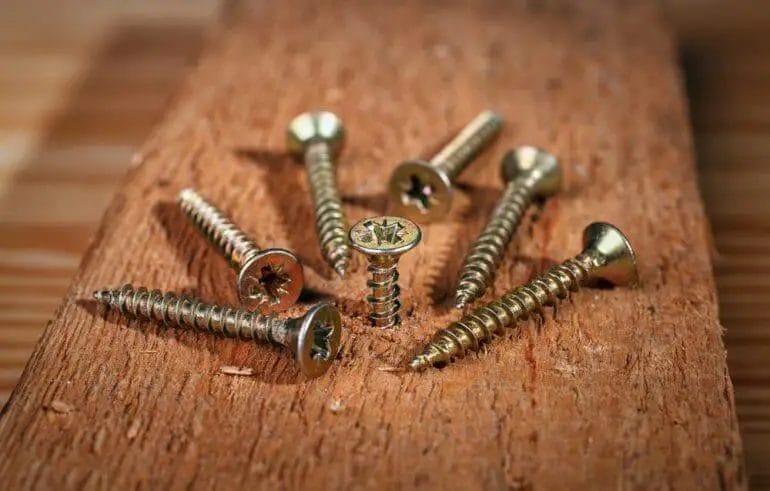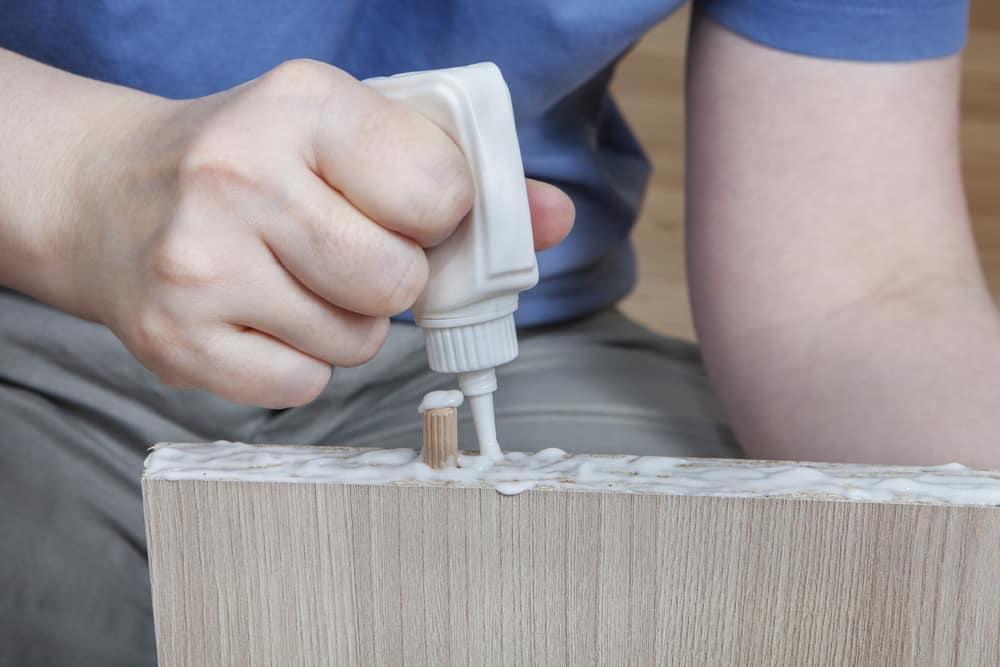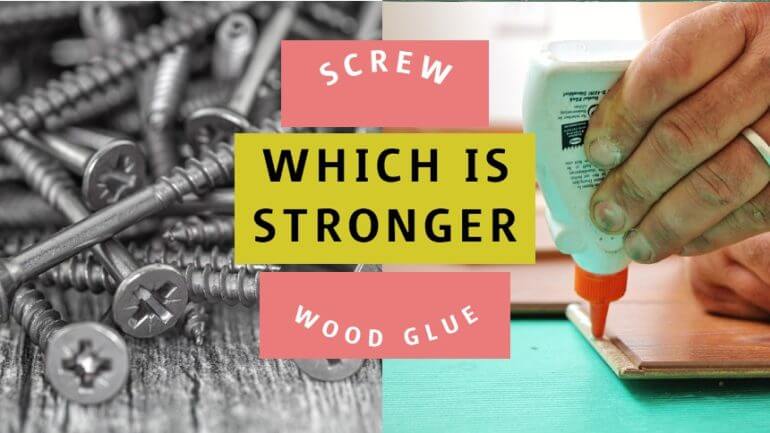Wondering if wood glue is stronger than screws? While screws offer a reliable method of joining wood, wood glue can provide an exceptionally strong bond. Wood glue creates a chemical bond that spreads evenly across the surface, enhancing the overall strength and durability of the joint. Unlike screws, wood glue distributes stress evenly, reducing the risk of splitting or cracking. Additionally, wood glue eliminates the need for visible screw heads, resulting in a cleaner, more seamless appearance. Overall, wood glue can be an excellent choice for joining and reinforcing wood structures.

Learn Why Wood Glue is a Reliable Alternative to Screws
When it comes to woodworking projects, it’s common to think that screws are the go-to method for joining pieces of wood together. However, wood glue offers a reliable alternative that shouldn’t be overlooked. In this section, we will explore the benefits of using wood glue and why it can be just as effective, if not more so, than screws.

1. Strong Bond
One of the main advantages of using wood glue is its ability to create a strong bond between two pieces of wood. When applied correctly, wood glue can create a bond that is just as durable as using screws. The glue penetrates into the fibers of the wood, creating a solid connection that can withstand significant stress and weight.
Additionally, wood glue is not affected by changes in temperature or humidity, making it an ideal choice for projects that will be exposed to different environmental conditions. This ensures that the bond created by the glue remains strong and reliable over time.
2. Invisible Joints
Unlike screws, which leave visible holes in the wood, wood glue creates invisible joints. This can be particularly advantageous for projects that require a seamless and aesthetically pleasing finish. When using wood glue, the bond between the pieces of wood is concealed, resulting in a clean and professional look.
Furthermore, the absence of visible holes means that there is no risk of weakening the wood or compromising its structural integrity. With wood glue, you can achieve a strong bond without compromising the overall appearance of your project.
3. Versatility
Wood glue offers greater versatility compared to screws. It can be used on a variety of woodworking projects, regardless of the type of wood or the complexity of the design. Whether you’re working on a small craft project or constructing a piece of furniture, wood glue can provide a reliable and secure bond.
Moreover, wood glue can be used in conjunction with screws to reinforce the joints and improve overall stability. This combination of adhesive and mechanical fasteners can result in a stronger and more durable end product.
4. Ease of Use
Using wood glue is relatively easy and straightforward. Unlike screws, which require drilling and additional tools, wood glue simply needs to be applied to the surface of the wood. The glue is then spread evenly using a brush or a spreader, ensuring full coverage on both surfaces to be joined.
Once the glue has been applied, the two pieces of wood are pressed together firmly and held in place for a specified period to allow the glue to dry and create a strong bond. This process is quick and efficient, making it an attractive option for both beginners and experienced woodworkers alike.
5. Cost-Effective
Wood glue is generally more cost-effective compared to purchasing screws and other fasteners. A small amount of glue can go a long way in joining multiple pieces of wood together. This can result in significant savings, especially for larger projects that require numerous connections.
Furthermore, wood glue eliminates the need for additional hardware, such as screws, nuts, and bolts, which can add to the overall cost of a project. By relying solely on wood glue, you can keep your expenses down without compromising on the integrity and strength of your woodworking project.
Summary
Wood glue is a reliable alternative to screws when it comes to joining pieces of wood together. It provides a strong bond, creates invisible joints, offers versatility, is easy to use, and is cost-effective. Consider incorporating wood glue into your next woodworking project and experience the benefits it has to offer.

Comparing the Strength of Wood Glue and Screws in Different Applications
When it comes to woodworking projects, one of the most common questions is whether to use wood glue or screws for joining pieces of wood together. Both options have their advantages and disadvantages, and the choice ultimately depends on the specific application and the desired outcome.
1. Strength and Durability
Wood glue is known for its exceptional bonding strength. When applied correctly and allowed to dry, it creates a strong and durable bond that can withstand a considerable amount of force. Screws, on the other hand, rely on the mechanical connection between the threads and the wood to provide strength. While screws can provide a secure hold, they may not be as strong as a properly glued joint.
However, it is worth noting that the strength of a glued joint can vary depending on the type of wood being used and the surface preparation. Hardwoods, such as oak or maple, tend to have a higher bonding strength compared to softwoods like pine or cedar. Additionally, the surface should be clean, dry, and free from any contaminants for the glue to adhere effectively.
2. Flexibility and Ease of Disassembly
Wood glue offers excellent flexibility, which allows for natural wood movement and prevents the joint from cracking or splitting under changes in humidity or temperature. This is particularly important for projects like furniture that may experience frequent use or environmental variations. Screws, on the other hand, provide a more rigid connection, which may not be ideal for applications where flexibility is required.
When it comes to disassembly, screws have an advantage over wood glue. If a joint needs to be taken apart or modified, unscrewing the screws is relatively simple. However, disassembling a glued joint can be challenging and may require cutting or applying heat to break the bond.
3. Aesthetics
In terms of aesthetics, wood glue provides a seamless and invisible joint. Once the glue dries and any excess is removed, the joint becomes virtually invisible. This makes it ideal for projects where a clean and professional appearance is desired. On the other hand, screws create visible holes that may need to be filled or covered with wood putty, affecting the overall appearance of the finished piece.
4. Application Considerations
Wood glue is commonly used for edge-to-edge bonding, where two pieces of wood are joined along their edges. This method allows for a larger gluing surface, resulting in a stronger bond. It is also suitable for laminating multiple layers of wood for increased strength and stability.
Screws, on the other hand, are often used for securing wood pieces at specific points, such as attaching a tabletop to legs or joining two boards at a corner. They provide a quick and reliable method of assembly and allow for easy adjustments during the construction process.
Summary
In summary, both wood glue and screws have their advantages and disadvantages when it comes to joining pieces of wood together. Wood glue offers exceptional bonding strength, flexibility, and a seamless appearance, but can be challenging to disassemble. Screws provide a secure hold, ease of disassembly, and are suitable for specific applications where flexibility is not a concern. Ultimately, the choice between wood glue and screws depends on the specific project requirements and desired outcome.

How to Choose Between Wood Glue and Screws for Maximum Strength
When it comes to joining two pieces of wood together, there are various options available, but two of the most common methods are using wood glue or screws. Both methods can create a strong bond, but the choice between wood glue and screws can depend on several factors. In this section, we will explore the considerations to help you choose the best option for maximum strength.
1. Purpose of the Joint
The first factor to consider is the purpose of the joint. Are you looking for a permanent or temporary bond? If you need a permanent bond, wood glue is an excellent choice. It forms a strong and durable bond that becomes a part of the wood itself. On the other hand, if you anticipate the need for disassembly in the future, screws provide a more convenient option.
2. Load-Bearing Capacity
If the joint will bear heavy loads, such as in structural applications or furniture construction, it is essential to consider the load-bearing capacity of the chosen method. Wood glue can distribute the load evenly across the joint, resulting in a strong connection. It also has the advantage of being able to bond larger surface areas, which enhances the overall strength. However, screws can provide extra reinforcement, especially when used in conjunction with wood glue. They can add mechanical strength and prevent the joint from separating under heavy loads.
3. Wood Type
The type of wood being joined can also influence the choice between wood glue and screws. Some types of wood, such as hardwoods, are dense and may require more force to penetrate with screws. In such cases, using wood glue can be a better option as it does not rely on the screw’s holding power. On the other hand, if you are working with softer woods or plywood, screws can provide a reliable and secure connection.
4. Aesthetics and Flexibility
Consider the aesthetic aspect of your project as well. Wood glue creates a seamless bond without any visible fasteners, which can be desirable for certain woodworking projects. Additionally, glue allows for greater flexibility in design, as it can bond irregularly shaped or curved pieces. Screws, on the other hand, may be more suitable for applications where visible fasteners are considered part of the design or where disassembly is required.
5. Time Constraints
Lastly, consider the time constraints of your project. Wood glue requires sufficient drying time to form a strong bond, typically ranging from a few hours to a full day. If you are working on a tight schedule and cannot afford to wait, screws offer a quicker alternative. They provide an immediate and secure connection without the need for drying time.
In summary, choosing between wood glue and screws for maximum strength depends on various factors such as the purpose of the joint, load-bearing capacity, wood type, aesthetics, flexibility, and time constraints. Understanding these considerations will help you make an informed decision and ensure a strong and durable connection between your wood pieces.
Enhancing Joint Strength: Secrets to Using Wood Glue and Screws Together
When it comes to woodworking projects, achieving strong and durable joints is essential. While there are various techniques to join wood pieces together, using wood glue and screws in combination can provide exceptional joint strength. In this section, we will delve into the secrets of effectively using wood glue and screws together to enhance joint strength.
Selecting the Right Type of Wood Glue
The first step in creating a strong joint is to choose the appropriate wood glue. There are different types of wood glues available on the market, such as PVA (polyvinyl acetate) glue, epoxy glue, and polyurethane glue. Each type has its own advantages and is suitable for specific applications.
PVA glue, also known as white glue or carpenter’s glue, is commonly used for woodworking projects. It is affordable, easy to use, and provides a strong bond. Epoxy glue is known for its incredible strength and versatility, making it ideal for heavy-duty applications. Polyurethane glue is a waterproof adhesive, perfect for outdoor projects. Consider the requirements of your project and choose the most suitable wood glue accordingly.
Preparing the Wood Surfaces
Before applying wood glue, it is crucial to prepare the surfaces properly. Ensure that the wood pieces to be joined are clean, dry, and free from any dust or debris. Smooth out any rough edges or imperfections using sandpaper. It is also advisable to make sure that the mating surfaces fit together snugly without any gaps or misalignment.
Applying Wood Glue
Once the wood surfaces are properly prepared, it’s time to apply the wood glue. Squeeze a generous amount of glue onto one of the mating surfaces. Use a brush, spreader, or your finger to evenly distribute the glue over the entire surface. Be careful not to apply too much glue, as excess can lead to messy joints and weak bonds. A thin, even layer of glue is sufficient for a strong joint.
Securing the Joint with Screws
Wood glue alone may not provide enough strength for certain applications. To enhance the joint further, screws can be used in combination with wood glue. Before driving the screws, consider pre-drilling pilot holes to prevent the wood from splitting. Align the wood pieces properly and drive the screws through one piece into the other. The screws will act as reinforcement, adding mechanical strength to the joint.
Allowing Sufficient Drying Time
After the glue has been applied and the screws have been secured, it is crucial to allow sufficient drying time. Follow the manufacturer’s instructions on the glue bottle to determine the recommended drying time. Avoid applying excessive pressure or stress on the joint until the glue is completely dry. This will ensure optimal bond strength and joint stability.
Summary
Combining wood glue and screws can significantly enhance joint strength in woodworking projects. Start by selecting the appropriate wood glue for your application. Prepare the wood surfaces, ensuring they are clean and properly aligned. Apply a thin, even layer of wood glue and then secure the joint with screws. Allow ample drying time before subjecting the joint to any stress. By following these secrets to using wood glue and screws together, you can achieve robust and long-lasting joints in your woodworking endeavors.
FAQs
Is wood glue stronger than screws?
Wood glue is not necessarily stronger than screws, but it provides a strong bond that can effectively strengthen joints. Glue distributes the load evenly over a larger area, while screws provide additional mechanical strength. For optimal strength, it is recommended to use both wood glue and screws together in woodworking projects.
Conclusion:
In conclusion, when it comes to strength, wood glue and screws serve different purposes. While wood glue offers a strong bond that evenly distributes stress across the joint, screws provide mechanical strength and reinforcement. Therefore, it is not a matter of one being stronger than the other, but rather understanding their distinct functions.
Wood glue excels in creating a seamless connection between two pieces of wood, eliminating the need for visible hardware and allowing for more flexibility in design. On the other hand, screws provide a reliable and easily adjustable fastening method, ideal for applications where disassembly and reassembly may be necessary.
Ultimately, the choice between wood glue and screws depends on the specific project requirements and the factors mentioned above. Consider the intended use, load-bearing needs, and desired aesthetic appeal to determine the most suitable approach.